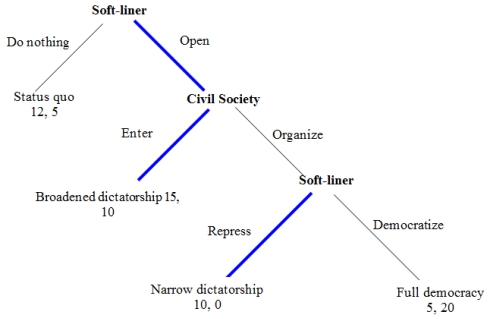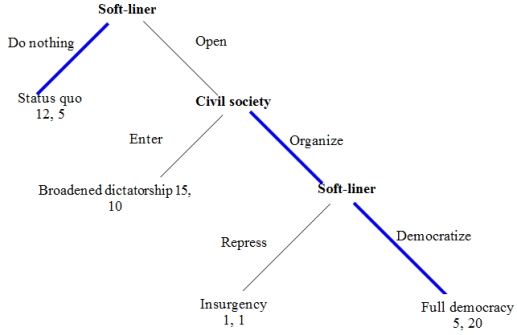Democratic Transition Game
Consider the case that you are a soft-liner in an authoritarian regime who would like to introduce a policy of liberalization. Your goal is to co-opt the opposition into a broadened dictatorship, not to transition to democracy. You are a dictator, not a democrat!
1. If you open and civil society enters, then you achieve your objective of a Broadened Dictatorship.
2. If you open and civil society organizes, then you need to decide whether to democratize and become a full democracy or to repress.
3. A successful repression will lead to a narrow dictatorship, whereas an unsuccessful repression will lead to insurgency.
4. Repression is successful only if civil society is weak.
Figure 1

Figure 2

-The game tree in Figure 2, is associated with the game in which you are sure that civil society is STRONG. Solve the game by backward induction. What is the subgame perfect Nash equilibrium?
Definitions:
Gender Scripts
Culturally constructed expressions of gender roles that dictate how individuals should behave, think, and feel based on their sex.
Social Position
An individual's rank or status within a social hierarchy, which can influence their access to resources and opportunities.
Socializing Activities
Activities designed to facilitate interaction and build relationships among team members or within organizations.
Gatekeeper
An individual who controls access to information or resources, acting as a filter or bridge between different sections of an organization.
Q1: Countries with electoral tiers above the district
Q5: Imagine that a scholar wants to develop
Q8: Which of the following is an example
Q15: Describe a major challenge for the just
Q22: One of the insights from the Exit,
Q22: "Countries have many parties only WHEN THEY
Q23: What are the two major limitations and
Q25: A good example of a president-parliamentary regime
Q28: Some scholars argue that elections in dictatorships
Q32: Solve the subgame on the right, where